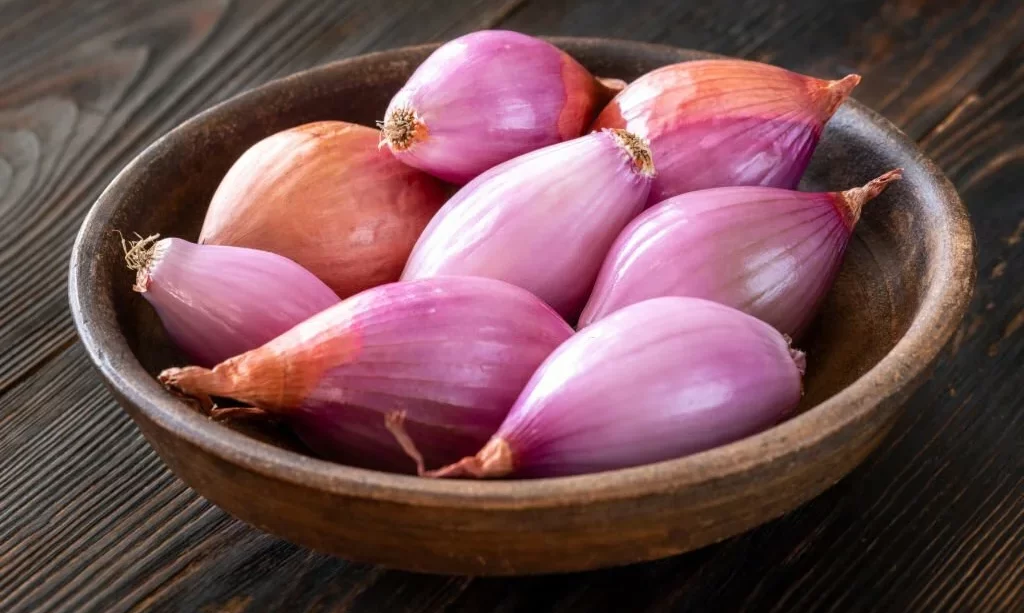Shallots, with their delicate and sweet flavor, are a beloved ingredient in many culinary creations. However, they are not always used up quickly, and their shelf life can be limited. This leads to a common question: “Can you freeze shallots”? In this article, we will explore the practice of freezing shallots as a method to extend their usability. We will dive into the reasons for freezing shallots, the proper preparation for freezing, and the potential benefits of having this versatile ingredient readily available in your kitchen.
- 2 lb. Fresh Shallots
- Produce of USA.
Why Freeze Shallots?
Freezing shallots offers several compelling reasons for home cooks and food enthusiasts:
- Preventing Waste: Shallots are often sold in clusters or bags, and it’s not uncommon to have more than you can use before they start to deteriorate. Freezing can prevent waste and save you money.
- Convenience: Having frozen shallots on hand can be incredibly convenient. They eliminate the need for last-minute trips to the store and speed up meal preparation.
- Preserving Flavor: Freezing shallots can help preserve their distinct and delightful flavor, making them a useful addition to various dishes.
- Batch Cooking: If you enjoy batch cooking or meal prep, freezing shallots can be a time-saving strategy. You can prepare a large quantity at once and use them as needed.
Preparing Shallots for Freezing
Before freezing shallots, it’s crucial to prepare them correctly to maintain their quality. Here’s how to do it:
- Peeling: Start by peeling the shallots. This can be a bit tedious due to their small size, but it’s an essential step.
- Chopping: After peeling, chop the shallots into your preferred size. Common choices are diced or minced. Smaller pieces are more versatile and convenient for cooking.
- Separating Layers: Shallots naturally form layers. After chopping, make sure to separate these layers, so they don’t freeze into a clump.
Proper preparation ensures that your frozen shallots remain easy to use and retain their flavor when it’s time to include them in your recipes.
Freezing Shallots: Methods and Containers
When it comes to freezing shallots, there are various methods and container choices available. Here’s how you can go about it:
- Flash Freezing: Spread the chopped shallots on a baking sheet in a single layer and place them in the freezer. Once they’re frozen, transfer them to an airtight container or resealable bag. This method prevents the pieces from sticking together.
- Vacuum Sealing: If you have a vacuum sealer, this can be an excellent option. Place the chopped shallots in a vacuum-seal bag, remove the air, and seal it. This method helps maintain the quality of the frozen shallots.
- Airtight Bags or Containers: You can also use airtight bags or containers specifically designed for freezing. Be sure to remove as much air as possible to minimize freezer burn.
Remember to label your containers with the freezing date so you can keep track of their freshness. Properly sealed containers can help protect the shallots from freezer burn and maintain their flavor.
- The Easiest Way To Freeze Your Favorite Foods: Instead of plastic containers that crack when frozen, use these flexible BPA free food storage containers; They’re perfect for storing leftovers, soup, sauces, broth, ice cubes, chili, stew, and so much more.
- Easy-To-Read Measurement Lines: Our silicone freezer trays have one 6 Cup compartment, and each one comes with easy-to-read fill lines: 2-cup (500mL), 4-cup (1000mL), 6 Cup (1500mL) Each Ice Cube Measures 2″ x 9.25″ x 5″ These lines are ideal for portion control and meal prepping
- Made From Food-Grade Material: Each order includes (2) Extra Large 6-Cup Freezer Containers For Food Reusable With Transparent Lids; They’re made from flexible, food-grade silicone that’s ultra-durable; Our silicone containers are so tough that they can even be placed in the oven up to 450 degrees Fahrenheit (not the lids), microwave, and dishwasher safe.
- Stackable Design Helps Keep You Organized: We’re going to assume that space is at a premium inside of your fridge and freezer, right? Not a problem; Our reusable silicone freezer soup containers are stackable, so you’ll be able to save space and stay organized
- We Deliver Much More Than Premium Products: Our mission is to provide a customer experience that will leave a lasting impression; We’re always available if you have any questions or concerns, and proudly back each set with a No Hassle 30 Day Full Money Back Guarantee
Thawing and Using Frozen Shallots
Thawing and using frozen shallots is a straightforward process. Here’s how to do it:
- Thawing: Transfer the desired amount of frozen shallots from the freezer to the refrigerator. Let them thaw overnight or for several hours. This gradual thawing helps retain their texture and flavor.
- Using in Recipes: Frozen shallots can be used in a wide range of recipes, from soups and stews to stir-fries and sauces. While the texture may change slightly after freezing, it is often less noticeable in cooked dishes. The distinct flavor of shallots remains intact, making them a valuable addition to your culinary creations.
- Avoid Refreezing: Once thawed, avoid refreezing shallots, as this can further affect their texture and taste.
With the convenience of frozen shallots, you can enjoy their delightful flavor in your dishes all year round, even when fresh ones are out of season.
Potential Changes in Texture and Flavor
It’s important to note that while freezing shallots can extend their shelf life and preserve their flavor, there may be some changes in texture. Freezing can cause shallots to become slightly softer and potentially lose some of their crispness. However, in most cooked dishes, these texture changes are often less noticeable, especially when shallots are used as flavor enhancers rather than a primary ingredient. The distinct and delightful flavor of shallots remains relatively intact, making them a valuable addition to your recipes. When considering the potential changes in texture, it’s essential to weigh the convenience and flavor preservation against any minor alterations in texture.
Conclusion
In the world of culinary exploration, freezing shallots is a practical way to prevent waste, enhance convenience, and extend the usability of this versatile ingredient. While there may be minor changes in texture after freezing, the distinct and delightful flavor of shallots remains largely intact, making them a valuable addition to various dishes. The choice to freeze shallots ultimately depends on your cooking style, preferences, and the specific recipes you enjoy. So, whether you’re preparing a savory sauce, a hearty stew, or a flavor-packed stir-fry, frozen shallots can be a reliable ingredient, ready to elevate your culinary creations with their unique and sought-after taste.





